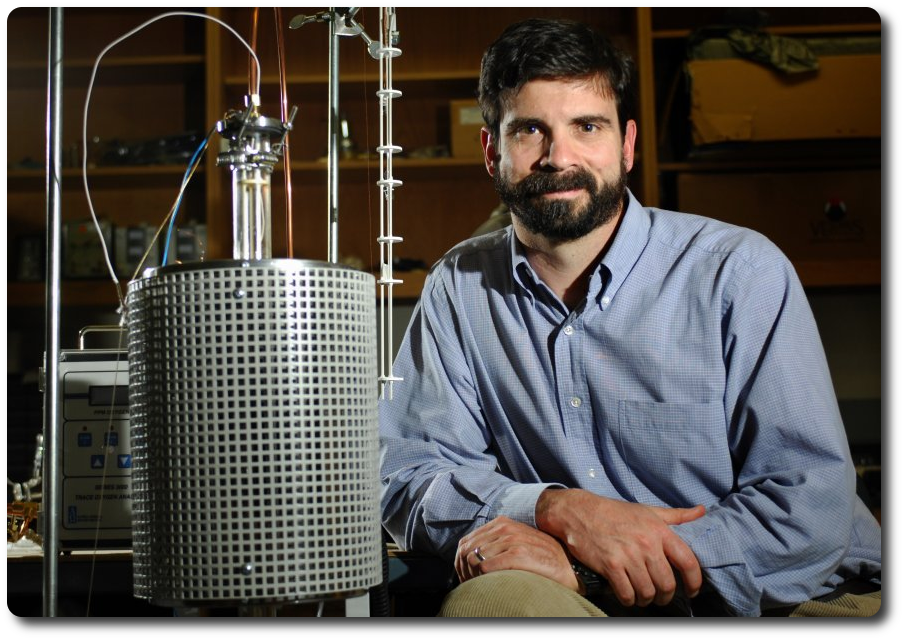Please note this webpage has not been updated since I moved into administration in 2014.
A more recent bio can be found on the UM Senior Leadership page.
Research Overview
Resonant Ultrasound Spectroscopy
RUS is an elegant and efficient method of obtaining the full elastic tensor of a crystalline material. Elastic constants are a sensitive probe into the atomic environment and so provide useful information about phase transitions. Our group specializes in high temperature and hydostatic pressure RUS measurements and analysis of thin films deposited on a substrate. Current materials we are investigating are novel thermoelectric compounds such as silicon germanium, Zintl phase materials, PbTe, and LaTe and the charge order transition in transition metal oxides. We have also worked on novel ceramics for high temperature hydrogen fuel cells.Structural Health Monitoring
In the Fall of 2015, we began a collaborative $3M project, funded through the DOE NEUP Integrate Research Program, to study various technologies to assess the structural health of spent nuclear fuel rod dry storage casks. This project brings together teams from UM Physics and NCPA, University of Florida, University of South Carolina, and Oregon State University as well as private sector partners AREVA Corp. and Electric Power Research Institute.
Wormlike Micellar Materials
Wormlike micellar fluids are simple mixtures of surfactants, organic salts and water which self-assemble into rich set of structural phases depending on concentration and temperature. Sometimes called "living polymers", these structures are loosely bound, can break apart under shear flow and recombine (self-heal). In the summer of 2007, we published a PRL paper reporting flow and fracture dynamics of a cylinder moving through a highly concentrated wormlike micellar material. Currently we are studying shear wave propagation in these highly viscoelastic materials as concentration, temperature, and acoustic pulse power are varied. The birefringent optical properties of these fluids allow us to use novel laser based methods to track shear pulses.Continuum and Granular Dynamics
In recent years we have studied a number of interesting mechanical systems including dynamic buckling of thin beams [PRL] and normal modes of vibration of heterogeneous nanostructures such as single and multiwall carbon nanotubes [JAP]. We are also beginning a study of dynamic instabilities in granular systems subject to fluidized vortical flow. These studies use numerical simulation and experimental methods such as particle image velocimitry (PIV) to better understand critical phenomenon in these unique systems.Teaching
Scientific Computing (Phys 730)
I have designed a new type Scientific Computing course which is aimed at a broad spectrum of advanced undergraduates or beginning graduate students from a range of disciplines including Physics, Chemistry, Biology, and Mathematics. The course teaches fundamental concepts which are common to all scientific fields such as numerical derivatives and integration, regression analysis, graphical representation of data, and systems of ordinary differential equations. As time allows, we also have covered more advanced topics such as concepts in parallel computing. I have found the Python programming language to be a good medium for the course.Advanced Classical Mechanics (Phys 709)
This graduate level course in classical mechanics introduces students to the core mathematical tools for many areas of theory - Lagrangian and Hamiltonian approaches. The first semester focuses on collections of point masses, rigid bodies, rotations, and oscillating systems. The end of the coarse brings us to the jumping off point for the foundations of quantum mechanics.
Introductory Physics (Phys 213/214)
An algebra based course primarily for pre-med students. I taught this course 2005-2010. (Physics 213/214)Calculus based Engineering Physics. I have taught this course from 2010 - 2012. (Physics 211/212)
Physical Theory (Phys 303)
A calculus based course designed to as a bridge for students who have completed the algebra based sequence and have decided to become physics majors. (Physics 303)Physics MCAT Review
Here is a link to the lecture slides for my Physics MCAT review session given Feb. 27, 2011. The file is intended for participants only and is password protected. If others would like access to the slides, please email me at the above address.iPad in the Classroom
Here are some slides I presented during Educational Technology Week and TACIT Training on the UM Campus on using the iPad for teaching related activities.� Mostly Tips and Tricks and some handy apps.
